I’d long heard of people using dish soap mixed with water to spray on broccoli and cauliflower in order to control aphids. I was curious to test that out. In early January, I had a row of plants and I had three kids that might enjoy helping me experiment.
Control methods
I wanted to test using soapy water against my usual method of spraying aphids off with a strong water stream from the hose. I asked if the kids had any other methods they wanted to try and my five-year-old son suggested trapping the aphids by putting some broccoli or cauliflower inside a trap. Because I couldn’t figure out how to build such an awesome mechanism, I settled on a different form of his suggestion by simply leaving some plants in the row alone so that maybe the aphids would concentrate on those “trap” plants more than those being sprayed with soap and water.
So those were our three methods: trap, soap, and water. The kids made labels and we randomly assigned them to plants.
Before getting started, we used a hand lens to get a closer look at the aphids we would be dealing with. Seeing the critters enlarged was fascinating to two out of the three kids; my oldest was grossed out and then no longer wanted to uncurl leaves to get access to the aphids for spraying since he might get some on his fingers.
Soapy water
It was on January 11 that I filled a plastic spray bottle with 16 ounces of rainwater plus a short squeeze of Mrs. Meyer’s Clean Day Dish Soap, Lemon Verbena scent (which is what was on the kitchen counter that day). As a team, we took turns spotting aphids on the plants — none of which had begun forming heads yet — and spraying the aphids with the soapy water.
From there, we returned to check our work every few days. We noticed that the sprays killed the aphids, but we also noticed that new aphids appeared in new areas on the leaves so we repeated the hunting and spraying every few days.
Water blast
Also on January 11, we commenced blasting aphids off leaves using a brass shut-off valve at the end of a garden hose. Rather than killing aphids in place, this technique knocked them off the plants. We saw that most then never crawled back up or flew back onto the plants. New aphids later appeared on different parts of leaves. Where the old aphids had been living and feeding was obvious as it was yellow.
Trap
It wasn’t until February 1 that we noticed a difference between the amount of aphids on the three different treatments. At this time, it became clear that most of the trap plants were becoming infested compared to the plants we were spraying and blasting.
On these trap plants we began to spot aphid mummies — brown, hollow aphid skeletons — and we got a closer look using the hand lens. These mummies had been parasitized by the wasp Diaeretiella rapae, presumably.
Without the need for a hand lens, one day we watched a syrphid fly visiting various colonies of aphids on the unsprayed and unblasted broccoli and cauliflower leaves. We (I) guessed that the syrphid fly might have been laying eggs near the colonies so its larvae could later feed on the aphids.
Here the kids learned about the various ways that various insects use and eat one another. The lesson for us was that our yard’s plants and animals are connected in ways that only reveal themselves when you slow down to observe.
Results
Here on February 19 our harvest is about over and the results are in. It was plain as day that the trap plants generally had more aphids than those treated with soap or water.
Generally. One broccoli trap plant harvested on February 9 had almost no aphids, inexplicably.
The sprayed and blasted plants all produced heads that appeared to have almost no aphids from the top.
However, I always found a few aphids hiding within a few florets, especially those within the tight center of each head. Our sprays and blasts didn’t seem to penetrate the top of the head well enough, and it wasn’t possible to spray or blast from underneath because of the stems and leaves in the way.
The soap plants had slightly more aphids than the water plants. I suspect this was because the water blast was stronger and reached inside the head better. The soapy water was not sprayed with nearly the velocity of the water blasting out of the hose.
Going forward
I don’t think I’ll use a soapy water spray again since it wasn’t more effective than blasting with just water. But I’m unsatisfied with even a few aphids tucked into a head of broccoli or cauliflower because it discourages me from sharing my harvests with friends and family. For the next crop, I have a new experiment in mind.
In order to keep rabbits from eating these ‘Cheddar’ cauliflower and ‘Batavia’ broccoli plants when they were young, I had draped tulle fabric over them. When I removed the tulle — a week or so before we started our experiment — I noticed that there were no aphids on the plants. The plants had grown well under the tulle, which let through almost 100 percent of the sunlight, and so my next experiment will be leaving the tulle on the plants all the way until harvest.
What did the kids learn?
In addition to the lessons I noted above, the kids were introduced to the rudiments of the scientific method through this experiment even though I never explicitly mentioned the term to them. But when asked directly what they learned from our experiment, my six year old simply answered, “I learned that spraying soap kills aphids.”
Is killing aphids a good thing? To him it is because it makes his cauliflower more palatable.
The kids also got some photography experience out of it. They took most of the photos in this post, as I’d asked them to help “document” our experiment. Here is my favorite of theirs:
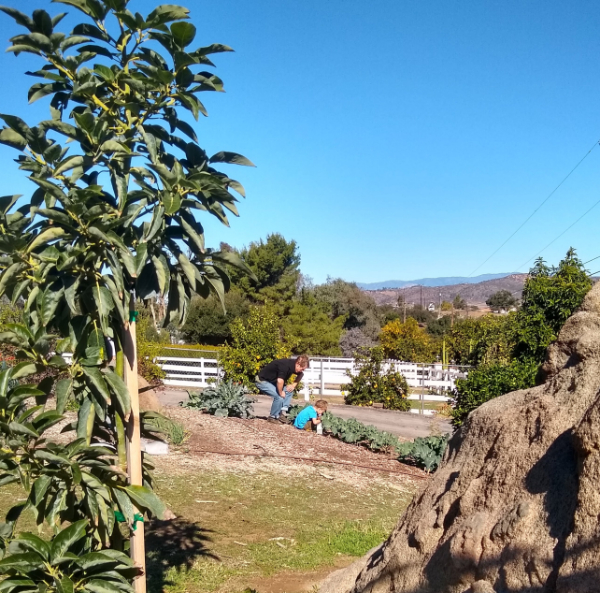
HERE is a more general post about dealing with aphids on broccoli and cauliflower.
All of my Yard Posts are listed HERE

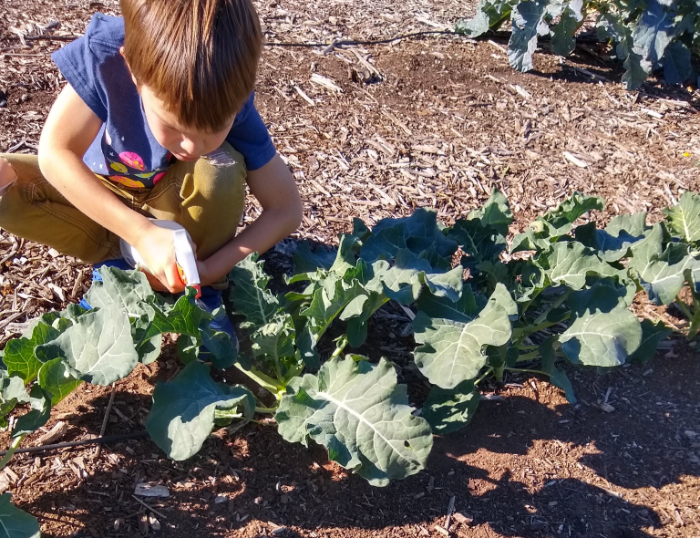
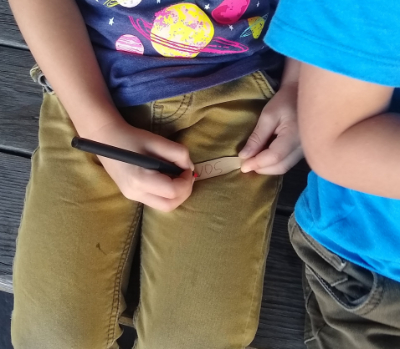
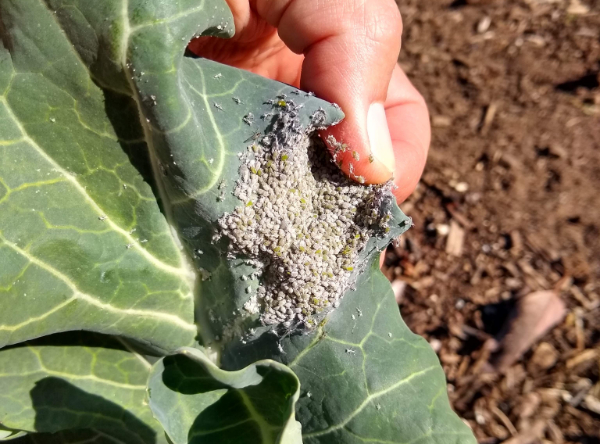
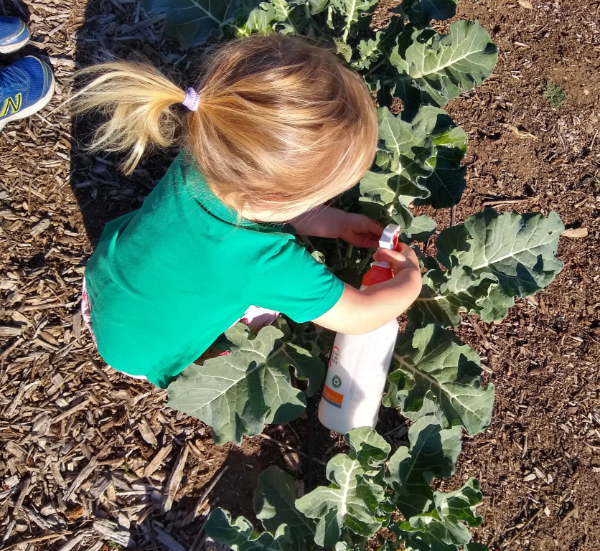
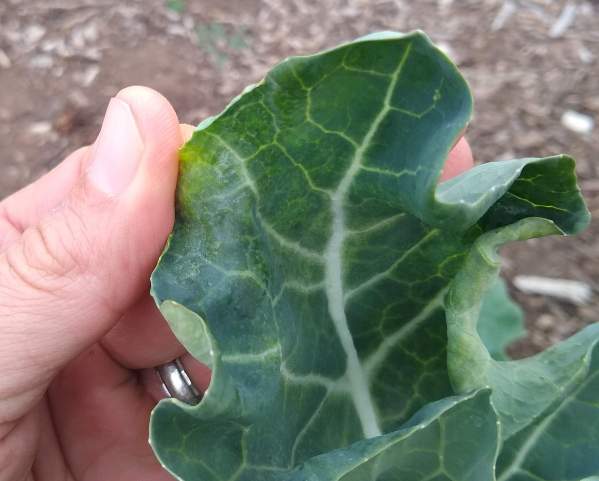
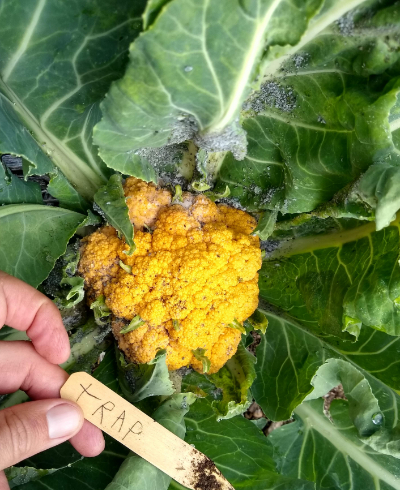
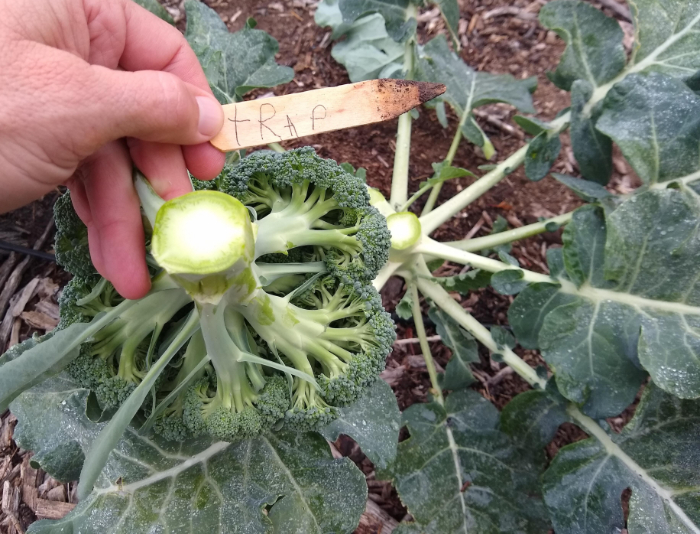
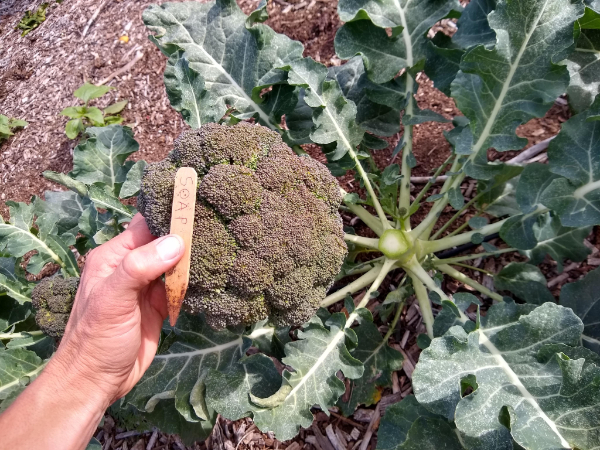
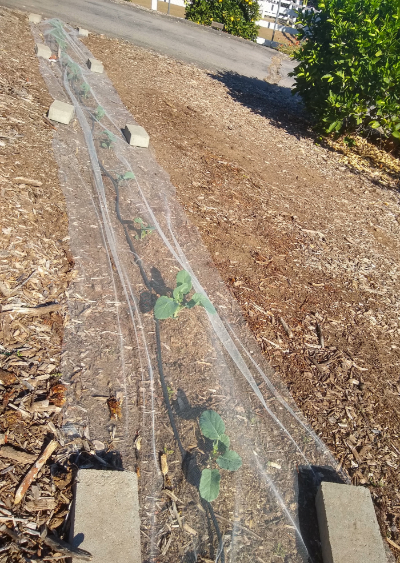
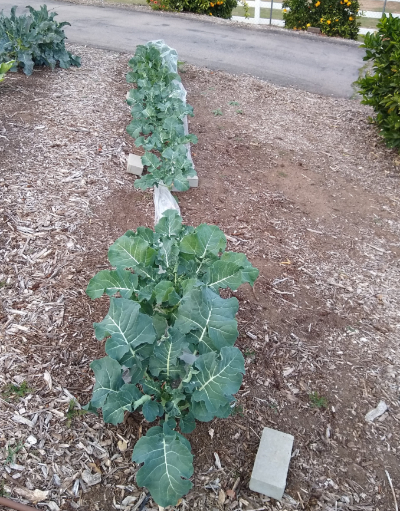



I would love to see a picture of how you applied the tulle fabric to your bed! The aphids were abundant in our yard this year too ?, even with lots of hose blasts!
Great idea, Corrie. I just added a couple photos of that.
That’s awesome! Thanks for sharing!! Love so much how you included your kids, such a great lesson for them!
Question re aphids:
On milkweed with caterpillars, and tender cocoons I cant spray with water. What other options are available? I usually pick them off manually but it’s often a race between the caterpillars and the aphids eating their food source.
Hi PJ,
In my experience, the oleander aphids on the milkweed are ugly but the monarch caterpillars and cocoons still do fine. Sometimes I rubbed a bunch of aphids off with my fingers but that’s it.
Greg, excellent parenting. Training your children as you are will give them skills and knowledge that will serve them throughout their lives. Big thumbs up to you!
Your article reminded me I’ve seen aphids on one of my Shasta Gold citrus yesterday and I forgot to spray them. I’m going to try an oil spray that I use on scale insects. Maybe you would like to do an article on scale for those of us with citrus trees.
Thanks a lot, Rick! I dealt with a lot of scale on my lime tree over the past couple years. There hasn’t been nearly as much scale on my other citrus, for some reason. Good idea for a new post.
Once again, Greg, excellent timing for me. I’m growing “Ole Timey Blue” heirloom collard greens from seed for the first time and my young plants have aphid infestation. Like you, I’ve always preferred the strong water blast approach to aphid removal. Guess I’ll just keep at it. Santa Barbara.
Great experiment, with a control group and everything! I have used the foaming hand soap bottles with castile soap and water on my indoor plants with spider mites. I would pump the soap directly on the pest and they’d die off. It seems like water hose bursts and doing nothing worked well enough. That is what I usually do. Thank you for the posts. Wonderful pictures, kids!
I don’t like aphids.
Hi Greg, Fun post with kids learning. Using dish soap, “detergent”, as an insecticide is a controversial approach in some gardening circles, I’ve learned. There is most likely a significant differenced between Mrs. Meyer’s Clean Day Dish Soap and Dawn. I’m in the insecticidal soap camp when water blasts don’t work on aphids.
Hi Robert,
If you have a specific insecticidal soap product you’ve found effective on aphids, please let me know.
Hi Greg, I use Safer insecticidal soap on aphids. In the dish soap debate, there are many that feel plant friendly soaps are OK to use as insecticides, Dr Bronner’s Castile soap comes up often. My dog’s not in that fight.
Hi Greg. We have been plagued w/ aphids (and later in the season, whiteflies and spider mites) in our veggie garden. I just read Jessica Walliser’s book: Attracting Beneficial Bugs to Your Garden, a Natural Approach to Pest Control, so this time we started interplanting some of the recommended flowering plants in w/ our veggies to help attract beneficials. It’s early days for us, but so far, so good- first several heads of broccoli harvested and no aphids. We haven’t seen any yet on any of our winter greens, either. Time will tell, but I like her approach and we’re hoping it really works for us. (also- I don’t know Jessica and I don’t make anything off her book)
Hi Mike,
I also love this approach. I haven’t found that the beneficials always provide enough control to meet my own desires, but I continue to try to attract them and support them as far as possible (growing flowers, no sprays, etc.) — and I try to lower my expectations a bit.
Rather than bugs, the past few weeks I’ve been enjoying watching the birds help control aphids in my garden. White-crowned sparrows and others have been flocking through every morning and eating aphids off my kale, collards, and broccoli.
I loved her books!! Is the interplanting working? One garden book I read (I think it was one of hers) mentioned that heliopsis helianthoides tends to attract aphids, so I’m just planting some seeds that I cold stratified in the fridge. I guess the idea is that keeping a constant supply of aphids attracts the predators so that they’re on hand to defend your food plants. Apparently nasturtium works great for that too, but it’s getting too hot for mine. I’ve also noticed I keep getting ladybugs on my basil (dolce vida large leaf, probably any tender leaf one works) even in the greenhouse, so I’m thinking I should root out some cuttings and add them around the garden. I also have a lot of perennials in the asteraceae family started as well as a bunch of alyssum. I figure I’ll plant them all out in October and see what makes it.
Brilliant article Greg. Thanks to you and your kids for conducting this experiment.
Melbourne, Australia